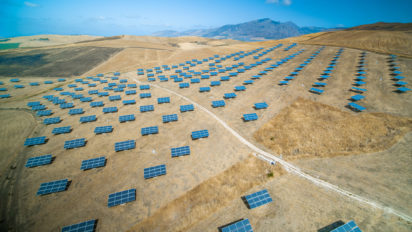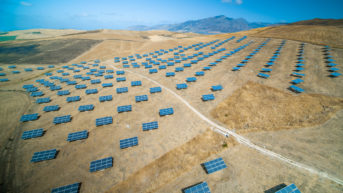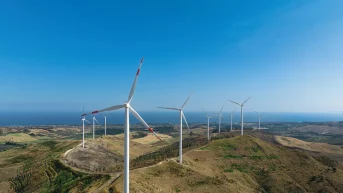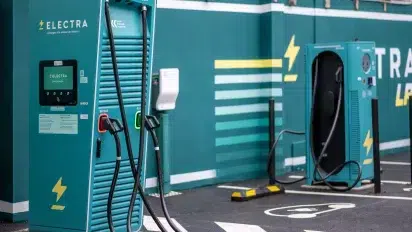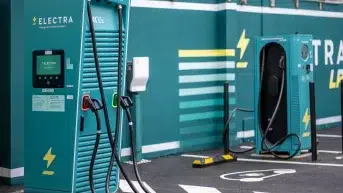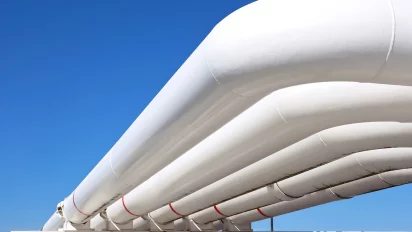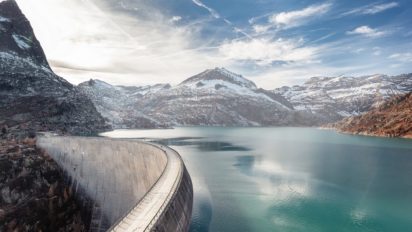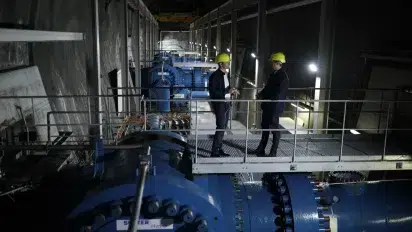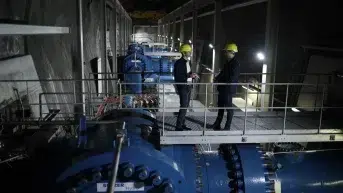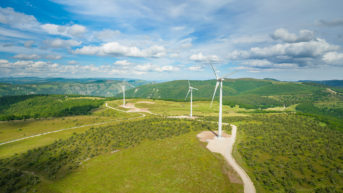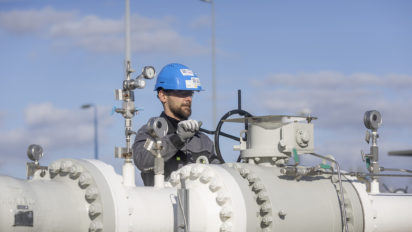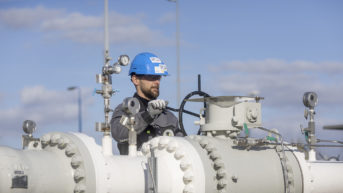St. Gallen Business Review: Investing in the Infrastructure Asset Class

For the original publication, click here.
In the past year, the energy markets were faced with many unprecedented challenges. At Energy Infrastructure Partners, you have been dealing with critical infrastructure since 2014. In your eyes, what market conditions have led to the current situation?
This question is exciting. Many people think that the reason for the problems in the energy markets is the war in Ukraine. But we don’t believe that the explanation is that simple – the causes lie much deeper. We see the war in Ukraine less as a cause and more as a trigger. The war itself started at a time when the situation in the energy markets was already very tense. Let me give you an example: At that time, about half of France’s nuclear fleet was undergoing an overhaul, which also lasted longer than originally planned. The fact that this refurbishment then coincided with the onset of the war was of course very unfortunate, especially since the overhaul of the nuclear power plants had already reduced the amount of electricity fed into the European energy grid – and now the flow of gas from Russia to Europe was also being throttled. The market reacted very sensitively to this. Of course, the fact that in the past the focus of the expansion and restructuring of the energy system was primarily on decarbonization, and less on the security of supply, also contributed to this.
Very interesting perspective! In the meantime, some of the problems you mentioned have been partially resolved – in France, for example. However, it doesn’t seem that energy prices have largely returned to normal. What is the reason for this?
Currently, seven nuclear power plants in France are still disconnected from the grid. That is one factor. Another factor is that missing Russian gas has to be replaced by substitutes. Any substitute for Russian gas is more expensive than the Russian gas itself. As the gas is then converted into electricity, the electricity becomes correspondingly more expensive. This is because a so-called merit order model is followed in the electricity market. Here, power plant capacities are ordered according to increasing marginal costs. Pricing is then determined by the power plant with the highest marginal costs that are just needed to meet market demand. Due to the general shortage of energy, gas-fired power plants in Europe are usually the power plants that are just needed to meet the demand for electricity. As a result, they act as price-setters, also for all other forms of energy.
So when people ask how long it will be before we get back to pre-crisis electricity prices, the unfortunate answer is: it won’t happen that quickly. As long as any substitute for Russian gas is more expensive than Russian gas itself, electricity prices will remain high.
Certain substitutes for Russian gas are likely to become available relatively quickly. This attempt to find substitutes for the lack of gas from Russia as quickly as possible could perhaps also negatively affect investments in renewable energy sources. Do you share this fear?
I also believe that appropriate substitutes will be available quickly, whereas investments in sustainable energy sources, which may even be much cheaper in the long term, cannot be implemented as fast. The construction of LNG terminals in Germany proves exactly that. Such constructions, which today take less than 10 months, would probably not even have been completed in 10 years before the current crisis. The expansion of renewable energies, on the other hand, continues to be very time-consuming due to lengthy approval procedures, even though renewables could be built quite quickly compared to conventional energy producers.
By expanding renewables faster, close to the consumer, we can not only reduce our CO2 emissions but also increase our security of supply from a geopolitical perspective.
We will come back to the issue of sustainability later. But to stay briefly on the subject of supply security and current market conditions, do you see any likelihood of simplifying and accelerating planning and approval procedures for sustainable energy sources as in the case of LNG terminals?
At the very least, we can observe an effort on the part of politicians to do just that in many countries. Switzerland is a good example of this, but we are also seeing something similar in other European countries, such as France. Personally, I would argue that the current environment must also be understood as a favorable environment for the restructuring of our energy system. This also involves questions of decentralizing and restructuring the power grids, which have so far been designed inflexibly and built mainly for large centralized plants. Finally, it is not only a question of generating energy, but also of distributing it in a sensible manner. All of this leads to an enormous need for investment. Fortunately, we are seeing the appropriate political will in this regard.
Very exciting! Let’s move on to another topic. With your company Energy Infrastructure Partners, your original goal was to make renewable energies investable as well. You have made many investments in this area since then. What is your next goal?
In the beginning, we wanted to make energy infrastructure investable for the Swiss population via insurance companies and pension funds. We have continued to grow from the inside out over the years since we were founded. Even during our early days, we were asked why we only invest in energy infrastructure. It was always clear to us that energy infrastructure is a defensive sector in the infrastructure asset class, which also has enormous economic significance. That’s why we want to focus precisely on this, which means that we can only grow by expanding our geographical scope. This is exactly what we have done, for example, with a fund set up solely for foreign investments. At the moment, we have an office in Luxembourg in addition to our office in Zurich. We are currently setting up an office in Germany. After that, we want to grow outside Europe with locations in the USA and Asia.
One region you did not mention is Latin America. Enormous infrastructure investments are particularly needed there. Why is Latin America not a priority for you?
As you correctly said, Latin America is not a priority for us. We have applied a very strict filter when selecting the regions in which we currently want to invest. We want to invest primarily in areas where we expect stable conditions in the long term. Criteria in the selection process include, for example, an investment grade rating of the relevant countries and an MSCI ESG Government Rating of at least BBB at the time of investment. In addition, the countries must be members of the OECD. These three filters eliminate a large number of countries: In Latin America, this leaves only Chile, which is not our focus.
Instead, we want to focus outside Europe on countries such as South Korea, Japan, Australia, and New Zealand. In such countries, we find an appropriately high level of legal certainty. Since we have a long-term horizon, this is particularly important to us. We also find such an environment in the USA. The Infrastructure Investment and Jobs Act was only recently passed, which provides for enormous investments in energy infrastructure as well. In such a market, we want to be all the more present.
In private equity, the usual investment horizon is around seven years. Is it at all possible to realize such an investment horizon with investments in energy infrastructure, that is, to sell the investment again after seven years?
You raise an interesting point. Our primary objective is not to generate capital gains, but to reap cash flows over the long term. That’s why when we started Energy Infrastructure Partners, we always said that the typical private equity investment horizons are much too short for this. Even for solar plants, we are speaking of an investment horizon between 25 and 35 years. For hydropower, this is between 40 and 80 years.
Many utilities have also realized over the last few years that there are different types of financial partners with different investment horizons. We have stated from the onset that we want to invest for the very, very long term. That’s why, on the one hand, we have set up vehicles that have an open investment horizon, so-called open-end structures. On the other hand, we have also set up closed-end structures, which are investment structures with a defined investment horizon, in our case usually over 25 years. With such structures, we have great advantages when sourcing investment opportunities. This is particularly the case when it comes to working with the public sector, but we are also much more attractive for industrial partners because we think very long-term.
Let’s leave aside pension funds as limited partners in your funds for the moment. Looking towards international investors who usually do not expect an exit after 25 years, have you seen a similar shift towards longer investment horizons in recent years?
What we are indeed seeing is a growing interest in long-term investment vehicles that harvest cash flows over many years. Aside from pension funds, insurance companies and sovereign wealth funds are particularly interested in these long investment horizons. Family offices are also showing growing interest. We have also noticed that limited partners that invest in products with a shorter term of ten years, for example, often reinvest the money in the same asset class after the cash-out. However, an investment always involves costs, for example for lawyers or advisors. Thus, many have come to the realization that investing over longer investment horizons can be more cost-effective in this aspect.
The term has a negative connotation, but that would make Energy Infrastructure Partners comparable to an energy conglomerate, wouldn’t it?
We prefer to talk about a balanced, diversifying portfolio. But the main value for us is in the ongoing cash flows.
You are acting as a private investor in often critical infrastructure. In this respect, there is usually sufficient public interest and much of the infrastructure is already highly regulated. Do you see a conflict between aspects of market freedom and public interest?
I believe that private operators and the public hand should ultimately work together closely: That’s where the solution lies. The private sector is usually very good at accumulating capital and then moving it to the right places. The biggest contribution that the public sector can make is to provide a stable framework for the long term, so that uncertainty on the part of investors can be prevented. Stable conditions help to reduce volatility, i.e. risk, which in turn reduces risk premiums. Ultimately, this also reduces the cost of capital, which makes infrastructure investments more favorable overall. This observation applies to both equity and debt. The bottom line is that this is also beneficial for consumers, as it means that infrastructure can be operated more efficiently and at a lower cost. This, in turn, should actually also be in the interest of politicians.
In the last issue on the topic of aspiration, we also spoke with Mirjam Staub-Bisang, the Country Manager of BlackRock in Switzerland. One interesting statement she made was that it is also important to invest in assets that are not yet sustainable from the outset, in order to make them sustainable step by step. Some dirty assets are not going to disappear just because more and more investors are following clear sustainability guidelines. Does investing in previously environmentally unfriendly assets for the purpose of transformation also represent one of your approaches?
We certainly see these opportunities, although it must be said that we would never invest directly in coal or oil ourselves – that is also a risk consideration. But what I would say is that gas, in particular, has a right to exist in a transition phase. Presently, we would not be able to keep the energy system stable enough with renewables alone. At any given time, as much electricity must be fed into the power grid as is being withdrawn at the same time. If this is not the case, then the entire power grid becomes unstable and endangers the security of supply. Renewables alone cannot generate a secure baseload due to the volatility of wind and sunshine. To stabilize the supply situation, we, therefore, need pumped-storage and gas-fired power plants, for example, which can be connected to the grid very quickly to compensate for any lulls in renewables at peak load times. That’s why gas-fired power plants currently have their raison d’être. Interestingly, the gas transport infrastructure could also be reused for the transport of hydrogen. So there is a lot of potential in this area, even in the long term.
But not all that glitters is gold, and not everything that appears green is green. In Brazil, for example, there are hydroelectric dams that emit enormous amounts of methane through the decay of organic materials at the bottom of the reservoirs, which is around 25 times more harmful to the climate than the greenhouse gas CO2. Researchers estimate that the climate damage of such dams per kilowatt-hour of electricity is up to 40 times that of a kilowatt-hour produced by a coal-fired power plant. How are such climate dangers, some of which are not obvious, dealt with?
I can only speak for us on this issue. ESG is a very important and present issue. That means environmental, social, and governance issues. We even have a separate Investment Committee that initially reviews investments solely on the basis of these criteria. Only when the investment has been approved by this committee, it can move forward to the regular investment committee. Concerns such as the one you raised would, of course, be closely scrutinized. I am not a biologist, but I would imagine that these kinds of problems are also strongly related to where the dam in question is located in the first place and how much organic material is stored at the bottom of the lake.
You recently invested in Repsol Renovables, the sustainable subsidiary of the oil company Repsol. Other fossil fuel companies have also established subsidiaries focused on sustainable energy production in recent years. In the future, should more of these corporations partner with investors who already have experience in this area?
It’s exciting for industry partners to work with sector specialists like us. By selling minority stakes, companies increase their liquidity without relinquishing control. In the end, however, they have the choice of which partner to go with. That’s where it’s up to us to convince. We can do this through our expertise in sustainable energies and supply-critical energy infrastructure, as well as through our long time horizon of 25 to 30 years. With our know-how, we then help to move the company forward in the longer term.
Will such partnerships become even more important for you in the future?
Partnering with industrial companies is in our DNA. From the very beginning, we wanted to invest with industrial partners. The fact that we started working on this topic before everyone was talking about it helps us today, of course. For us, this idea also made sense at the time for risk considerations.
One might think that it is difficult for you to get new capital for investment at the moment, as infrastructure investments are very highly valued in asset managers’ portfolios. Excessive exposure to a market is usually avoided in order to minimize risks. Do you currently feel this?
It’s more that other asset classes have corrected, and infrastructure is overweighted among some investors as a result. However, we have talked about the huge need for investment. Along with other factors, this has a positive impact on expected returns and provides an incentive for investors to continue investing in the sector.
Is it perhaps also because institutional investors are paying more attention to ESG criteria and therefore want to invest specifically in sustainable energy infrastructure?
Definitely; this is a huge topic. In Switzerland, but also in the EU with the taxonomy, it is very relevant. You can’t really launch an investment vehicle anymore without taking ESG factors into consideration. But it also makes sense from a business perspective – after all, risks and opportunities are considered. I want to avoid risks as much as possible, and I want to realize opportunities. So it’s essential to consider issues like climate change, precipitation patterns, or similar factors. For us, this is also a part of the investment process that we look at closely.
You are not only stewards but also operators of critical infrastructure. Recently, we have seen more and more cyber attacks on infrastructure units. How do you plan to deal with this problem in the future and what precautions are you taking?
During my time at St. Gallen, I majored in information management and thus have a high affinity for this field. Especially in recent years, the explosiveness of this topic has increased greatly. In the past, you had to physically go into a plant to do damage. Since power plants have been digitized and connected to the grid, new protective measures must be taken. For us, in concrete terms, this means making even more frequent queries of security systems and taking appropriate measures to protect ourselves against such cyberattacks.
You just mentioned that in the past you had to physically go into facilities to do damage. The events surrounding the damage to the Nord Stream pipelines also point to physical sabotage. Does this mean that problems from the past are becoming topical again?
As a private-sector company, we do everything we can to ensure the physical protection of infrastructure units. However, when it comes to territorial integrity, this is fundamentally the responsibility of the state. The state must ensure that the population and, in particular, supply-critical infrastructure are protected. Politicians are very aware of this task. In this context, we try to minimize our risk through diversification and draw up plans to be prepared in a worst-case scenario and to minimize the damage. I also come back to what I said about the countries in which we invest. These already meet high-security standards.
In theory, it could be assumed that investments in Nordic areas should receive a higher risk premium due to the threat from Russia. Can this be seen in the market?
That is an interesting thought. So far, we haven’t observed this, which is probably due to the political stability and the strong military defense of these countries.
Leaving behind the many crises we’ve spoken about, what advice would you give to students who want to get to grips more intensively with the subject of infrastructure investing?
I can recommend reading a lot and doing internships. I think there are two clear reasons to be interested in infrastructure investment. On the one hand, you can invest pension funds’ money and contribute to beneficiaries having a better pension. On the other hand, you can participate in a transformation that moves our society forward. Overall, there is probably no other area that is as relevant to the national economy as the energy supply. During Covid, we saw that there was always an attempt to maintain the operation of necessary infrastructure, including by politicians.
To conclude: What gives you personal hope these days?
First and foremost, it’s the team that we work with. When I come into the office in the morning, there are 90 highly motivated specialists working every day on issues relating to investments in energy infrastructure. Working with employees from 26 countries every day never ceases to excite and motivate me. On the other hand, of course, it motivates me to see the impact we have through our work. Currently, our portfolio could supply the equivalent of half of all Swiss households with sustainable electricity.
Disclaimer
This document does not constitute individual investment advice and does not release the recipient from making its own assessment with respect to an investment. The recipient must not take any investment decisions solely based on the information contained in this document and shall, if necessary or appropriate in consultation with external advisers, assess the information based on the recipient’s individual circumstances in terms of suitability and appropriateness and any legal, regulatory, tax, accounting or other consequences such an investment may have.
Copyright © 2023 Energy Infrastructure Partners AG. All rights reserved.
